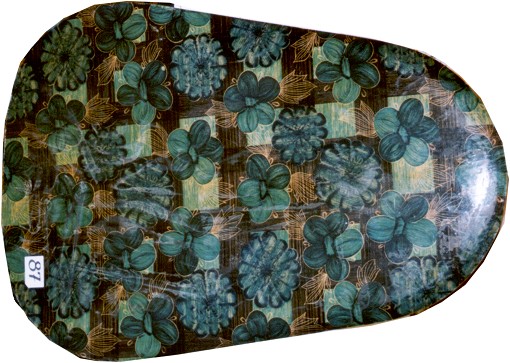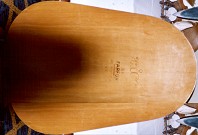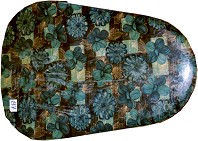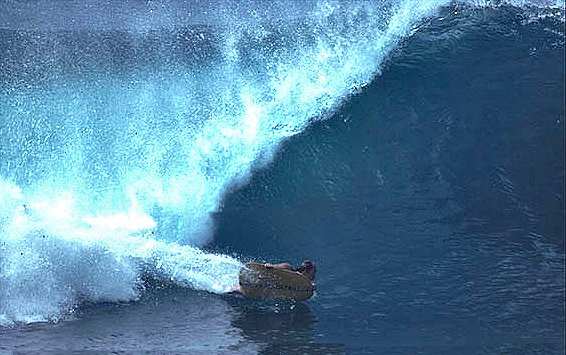 |
surfresearch.com.au
the catalogue #193 |
| home | catalogue | history | references | appendix |
|
|
|||||||||||||||||||||||||||||||||||||||||||||||||||
 |
|||||||||||||||||||||||||||||||||||||||||||||||||||
| MANUFACTURE
MANUFACTURER: Farfor SHAPER: Jamie Farfor DESIGN: Paipo DESIGNER: John Waidelich and Jim Growney |
|||||||||||||||||||||||||||||||||||||||||||||||||||
| SPECIFICATIONS
CONSTRUCTION Plywood with fabric laminated bottom. Branded decal. Varnished. DIMENSIONS
|
|||||||||||||||||||||||||||||||||||||||||||||||||||
|
|||||||||||||||||||||||||||||||||||||||||||||||||||
|
|||||||||||||||||||||||||||||||||||||||||||||||||||
| NOTES
BOARD HISTORY Dimensions and photographs Sydney Surf Auction, Mona Vale Hotel, Sydney, 25 - 26 September 2003 Catalogue No. 82 : " PAIPO BOARD 1960's All time rarity, plywood: great condition." Notes by Mick Mock PO Box 330 Manly NSW Australia 2095. Thanks to Mick Mock. Design History Bob Green emailed in August 2013, with thanks: "Paipo as used in Hawaii probably only developed wide tails in the early 1960s courtesy of John Waidelich and Jim Growney. Known as the Paipo Nui, Valentine commercialized, rather than developed these boards." An article, The Paipo Board by Val Valentine with photographs at Sunset Beach, appeared in The Surf Guide, January 1965. The header proclaimed It's smaller, faster ... and 300 hundred years old!
COMMENTS: emailed by Jamie Farfor 16 February 2005, with thanks... I was browsing, and came across one of the paipo boards that I designed and built long ago. I notice that you are a little short on detail, so I thought I would fill in some of the missing bits. I
watched Val Valentine as he made a Paipo for me in
Hawaii, and could see that there would be a better
way of doing it. Concave
tails to boards were all the rage that season, and
Val was spending much of his time trying to build a
concave Paipo that would work.
Back
in Australia, I built a press that had a concrete
base mould at table height, and was loaded with a
hydraulic powered airbag. I
started using timber vaneer, but was unable to get
suitable quality of material.
With
the stresses in the plywood, the curvature at the
nose was less than with the timber vaneer.
I
was never an obsessed body boarder, and used all
types of boards. Best regards, Jamie Farfor Note: In 1957, Jamie Farfor ordered a 9ft 10" balsa surfboard from Bill Clymer of Manly, and had the board shipped to Victoria. REFERENCES Other Boards
Surfworld Museum, Torquay Victoria. : Lamaroo # 26 See Paipo Catalogue Books Margan and Finney Photographs, pages 152 - 156 CONDITION: 9.5 |
|||||||||||||||||||||||||||||||||||||||||||||||||||
  bottom bottom
 Before bodyboards there was plywood.: Sean Ross, Pipeline, Hawaii. Board by Paul Lindbergh's Hawaii Paipo Designs. Photo: Alan (Bud) McCray. Sean was a life guard at the Ehukai Beach (Pipeline) during the1970's. Photo courtesy Rod Rodgers, Baltimore, Maryland : My Paipo Boards and ...More. David Swanson and his and Val Valentine's Paipo Collection, Haleiwa, 2000. Photo and article by David Pu'u The Surfer's Journal, Vol 9 No 3, 2000 Pages 122-123 |
|||||||||||||||||||||||||||||||||||||||||||||||||||
 surfresearch.com.au |
| home | catalogue | history | references | appendix |